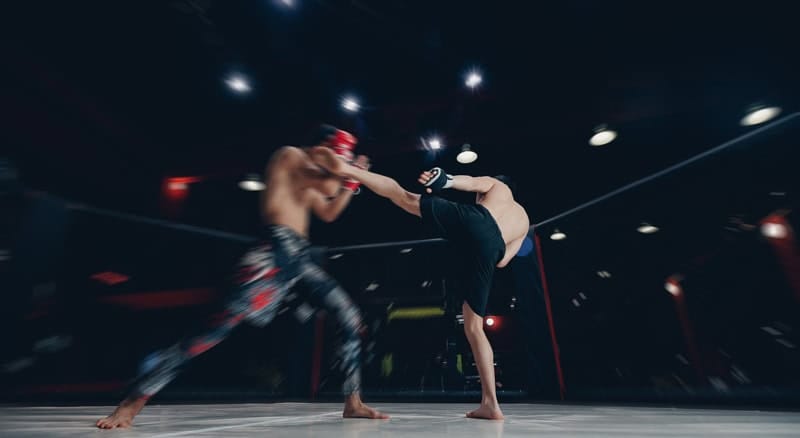My four decades in martial arts have given me a front-row seat to the remarkable transformation of combat sports. What were once niche activities—kickboxing and mixed martial arts—have now become mainstream athletic pursuits, each with a distinct identity that often confuses newcomers. A nuanced way to think about the kickboxing vs MMA is that kickboxing is a precision tool – like a finely crafted blade – while MMA is more like a Swiss Army knife, offering multiple options for any situation. Neither is inherently better; they simply serve different purposes and suit different goals. When weighing martial arts vs kickboxing or considering the pros and cons of MMA, it's crucial to understand what each discipline truly offers.
In this comprehensive guide, I'll break down the key aspects of both sports, drawing from my experience as a martial artist and avid student of combat sports to help you make an informed decision about which path might be right for you.
What is Kickboxing?
Standing at the intersection of traditional martial arts and modern combat sports, kickboxing emerged as a response to martial artists' desire to test their striking skills in full-contact competition. Through my years of observing and analyzing combat sports, I've seen kickboxing evolve from its inception in the 1960s into the dynamic sport we know today.
The essence of kickboxing lies in its focused approach to stand-up fighting. Unlike MMA's broader scope, kickboxing concentrates purely on striking techniques. The sport gained international prominence through innovators like Bill "Superfoot" Wallace, whose unorthodox kicking techniques revolutionized the game, and Dutch pioneer Ramon Dekkers, who helped establish the aggressive "Dutch style" that dominates modern kickboxing.
The core principles revolve around combining boxing's hand techniques with powerful kicks. Training focuses on punches like the jab, cross, and hook, integrated seamlessly with leg techniques, including roundhouse kicks, front kicks, and devastating knee strikes. What makes kickboxing particularly appealing is its straightforward yet effective approach to combat.
Benefits extend far beyond just fighting skills. The cardio demands of kickboxing make it an exceptional workout – something I've witnessed firsthand in countless gyms. Students often report dramatic improvements in fitness, coordination, and mental focus.
What is MMA?
Mixed martial arts represents the evolution of combat sports into its most comprehensive form. Having followed MMA's development since the early UFC days, I've watched it transform from a style-versus-style spectacle into a sophisticated martial art of its own. The difference between kickboxing and MMA becomes immediately apparent when you understand MMA's fundamental nature – it's a complete combat system that demands mastery of multiple disciplines.
The sport's modern era was revolutionized by pioneers like Royce Gracie, who showed how Brazilian Jiu-Jitsu could overcome larger, stronger opponents, and Georges St-Pierre, who demonstrated the importance of becoming truly well-rounded. As UFC commentator Joe Rogan noted in his podcast, "MMA isn't about being the best striker or the best grappler – it's about being the best at combining everything together."
The core principles of MMA encompass striking, wrestling, and submissions. This comprehensive approach means practitioners must develop proficiency in punching and kicking (from boxing and kickboxing), clinch work (from wrestling and Muay Thai), takedowns (from wrestling and judo), and ground fighting (from Brazilian Jiu-Jitsu). Mixed Martial Arts techniques continue to evolve as fighters innovate and discover new combinations of these fundamental skills.
Beyond the physical aspects, MMA offers unique benefits that set it apart from other combat sports. The mental challenge of managing multiple fighting ranges and techniques develops exceptional problem-solving abilities and adaptability.
Key Differences Between Kickboxing and MMA
Understanding the key differences between kickboxing and MMA helps clarify which path might better suit your goals. Let me break down these distinctions based on my years of observing and analyzing both sports.
Techniques and Skills
Kickboxing focuses exclusively on stand-up striking. The technical arsenal includes punches borrowed from boxing, kicks adapted from karate and Muay Thai, and knee strikes. According to an article in the Journal of Combat Sports Medicine, kickboxers develop specialized neuromuscular patterns that optimize striking efficiency from standing positions.
MMA, by contrast, demands proficiency across multiple disciplines. Fighters need to seamlessly transition between striking, wrestling, and submissions. The pros and cons of MMA become evident here – while it offers more tools, mastering all these aspects takes considerably more time.
Rules and Regulations
Kickboxing rules maintain a laser focus on stand-up fighting. Clinching is typically limited, and taking an opponent to the ground is prohibited. This creates a faster-paced striking exchange that many find more accessible to follow.
MMA rules vary significantly between amateur and professional competitions. Amateur MMA emphasizes fighter safety with additional restrictions – no strikes to the head of a grounded opponent, no elbow strikes, and shorter rounds (typically three 3-minute rounds). According to the Unified Rules of Mixed Martial Arts, professional bouts allow a broader range of techniques and typically last three 5-minute rounds (five rounds for championship bouts).
Training and Learning Curve
The training approaches for these sports differ significantly. Kickboxing's focused nature typically allows for quicker initial progress. You'll spend your time perfecting strikes, developing combinations, and improving cardio.
MMA training requires juggling multiple disciplines. One day you're practicing takedown defense, the next you're working on submission escapes. This variety can be both exciting and challenging, depending on your learning style.
Physical Conditioning
The physical demands of these sports reveal another crucial distinction between kickboxing and MMA. Through my observation of both disciplines, I've noticed how each shapes athletes differently.
Kickboxing conditioning centers on explosive cardio and striking endurance. Training emphasizes developing fast-twitch muscle fibers for powerful strikes while maintaining the stamina for multiple rounds of constant movement. According to research published in the Journal of Strength and Conditioning Research, kickboxers demonstrate exceptional anaerobic capacity and lower-body power output.
MMA conditioning requires a more complex approach. Athletes must develop strength for wrestling, endurance for grappling, and explosiveness for striking – all while maintaining enough energy to transition between these phases. Studies have shown that MMA fighters require a uniquely balanced development of aerobic and anaerobic systems to handle the sport's varied demands.
Competition Style
Kickboxing competitions maintain a consistent rhythm. Fighters focus on timing, distance management, and combination striking. The pace is often more predictable, though no less intense. According to Glory Kickboxing's official rules, matches consist of three 3-minute rounds (five rounds for title fights), with clear scoring criteria based on striking effectiveness.
MMA competition presents a more chaotic environment. A fight can shift dramatically at any moment – from striking to takedowns, from clinch work to ground fighting. The variable nature of MMA means competitors must be prepared for multiple scenarios and energy demands. UFC statistics show that championship-level fighters typically excel in at least two of the three main areas: striking, wrestling, or submissions.
Gear and Attire for Kickboxing and MMA
Having spent time in both traditional martial arts dojos and modern MMA gyms, I can tell you that equipment choices significantly impact your training experience and performance. Let's break down the essential gear for each discipline.
Kickboxing Gear
Kickboxing emphasizes specialized equipment for striking protection. Your primary investment will be 16-ounce gloves for training – these larger gloves protect both you and your training partners. According to the International Kickboxing Federation's equipment guidelines, proper gear is essential for both safety and performance.
Required MMA equipment includes:
- 4-6oz MMA gloves
- Rash guards and compression shorts
- Grappling-specific shin guards
- Essential protective gear (mouthguard, cup)
- Optional equipment like knee pads and earguards
Pros and Cons of Kickboxing
The striking art of kickboxing presents a unique set of advantages and challenges that every potential practitioner should consider. Let me share what I believe makes this discipline both appealing and limiting.
Pros of Kickboxing
Kickboxing offers a more focused path to striking excellence. The concentrated nature of the training means faster initial progress in stand-up fighting skills. According to fitness tracking data from several major gyms, kickboxing workouts burn an average of 800-1000 calories per hour, making them among the most efficient cardio workouts available.
- Clearer learning progression with fewer techniques to master
- Exceptional cardio development through consistent high-intensity movement
- Lower risk of serious injury compared to MMA's ground fighting
- Easier to train without specialized facilities
Cons of Kickboxing
Looking beyond the flashy kicks and combinations, kickboxing has its limitations. The sport's specialized nature means practitioners might face challenges in situations requiring different skills.
Notable limitations include:
- Restricted clinch fighting options
- Less adaptable for real-world self-defense scenarios
- Limited ground defense capabilities
Pros and Cons of MMA
Mixed martial arts stands as the most comprehensive combat sport today, bringing both remarkable opportunities and significant challenges to its practitioners.
Pros of MMA
The beauty of MMA lies in its versatility. According to a survey published in the International Journal of Sports Science, MMA practitioners reported higher confidence in self-defense scenarios than practitioners of single-discipline martial arts.
This adaptability creates several distinct advantages:
- Complete combat skill development
- Enhanced problem-solving abilities through multiple fighting scenarios
- Superior self-defense preparation
- Deeper understanding of combat principles
Cons of MMA
Make no mistake – this comprehensive approach comes with its own set of challenges:
- Significantly steeper learning curve
- Higher risk of injury due to diverse training demands
- More complex skill development timeline
- Greater time commitment required for proficiency
How to Train Effectively for Kickboxing
Having observed numerous gyms and training methods over the years, I've seen what works and what doesn't. The most effective approaches often come from elite trainers who've developed systematic methods for building skilled kickboxers.
Top kickboxing gyms emphasize progressive skill development. According to training methodologies by the
Dutch Kickboxing, effective training structures include:
- Technical striking sessions
- Cardiovascular conditioning
- Partner drills and controlled sparring
- Recovery and flexibility work
How to Train Effectively for MMA
The evolution of MMA training has been fascinating to watch. Modern approaches treat fighter development as a science rather than just hard training.
According to the
UFC Performance Institute's training guidelines, effective MMA development includes:
- Striking sessions (boxing, kickboxing, Muay Thai)
- Wrestling and takedown practice
- Ground fighting and submission grappling
- Specialized conditioning work
- Integration training (putting it all together)
The UFC's fighter development program is a perfect example of this insight, "The key isn't training harder - it's training smarter." Their methodology emphasizes understanding how different martial arts complement each other rather than treating them as separate disciplines.
Which One is Right for You?
Choosing between kickboxing and MMA comes down to understanding your personal goals and circumstances. From my time teaching martial arts and guiding students, I've found that several key factors influence this decision.
If you're seeking focused striking training with a straightforward progression path, kickboxing offers clear advantages. Kickboxing classes tend to have a higher retention rate for beginners compared to MMA training, likely due to the more approachable learning curve. MMA might be your path if you crave a more comprehensive martial arts experience.
- Available training time (MMA requires more)
- Local gym quality and coaching expertise
- Physical conditioning goals
- Competition interests
- Self-defense priorities
Kickboxing vs. MMA: Quick Comparison Table
| | |
|---|
| | Standup + Grappling + Ground Fighting |
| | Punches + Kicks + Knees + Takedowns + Submissions |
| Single-Discipline, Beginner - Friendly | Multi-disciplinary, Advanced |
| | Stand-up + Ground Fighting |
| | Overall Strength + Cardio + Weight Loss |
Final Thoughts
The evolution of combat sports has created two distinct paths that serve different aspirations. Through my martial arts background and years of studying both disciplines as an avid follower, I've observed how the focused striking art of kickboxing and the comprehensive nature of MMA each offer unique advantages for different types of practitioners.
Kickboxing provides a streamlined path to striking excellence, with clear progression and immediate feedback on your development. Its concentrated focus makes it particularly appealing for those seeking intensive cardio, straightforward skill development, and competitive striking opportunities. The disadvantages of kickboxing become apparent only when practitioners need a broader combat skill set.
MMA, while more complex, offers an unparalleled breadth of tactical options and problem-solving opportunities. The pros and cons of MMA reflect this breadth - greater versatility and self-defense application but with a steeper learning curve and more demanding training requirements.
What's most critical is aligning your choice with your personal goals. Consider your available time, local training options, and long-term objectives. Some find their passion in the focused intensity of kickboxing, while others thrive in MMA's diverse challenges. The difference between kickboxing and MMA ultimately comes down to your individual journey in martial arts.
Frequently Asked Questions
Is kickboxing easier to learn than MMA?
Yes, generally. Kickboxing's focused nature allows faster initial progress in striking skills, while MMA requires learning multiple disciplines simultaneously.
Which is better for self-defense: kickboxing or MMA?
MMA typically offers more comprehensive self-defense preparation due to its inclusion of grappling and ground fighting. However, kickboxing provides excellent striking skills that can be valuable in self-defense situations.
Can you train in both kickboxing and MMA at the same time?
Absolutely. Many fighters start with kickboxing to develop strong striking foundations before transitioning to or incorporating MMA training.
Is kickboxing safer than MMA?
There are many factors that go into this question. So it depends. Nonetheless, while both sports carry inherent risks, kickboxing typically involves fewer injury-prone scenarios since it doesn't include grappling, ground fighting, or submissions.



